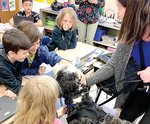

When the Quakertown Community School Board passed the Therapy Dogs policy at its Feb. 23 meeting, school counselor Eileen Bruchak was thrilled for the positive benefits it would bring to district students.
“I was really excited,” said Bruchak, the counselor at Quakertown Elementary School. “There will be so many benefits from this program in our work with kids.”
That was the idea when Assistant Superintendent Nancianne Edwards began researching the possibility two years ago. Edwards, an animal lover, is the administration’s representative on the School Board’s Policy Committee. She researched the type of model that would be best for the district, and after much work by the committee, Policy 718.1 was developed.
“I’m thrilled to be able to take this concept and make it a reality,” she said. “These therapy dogs will become part of the fabric of the building.”
The district’s therapy dogs will have handlers who, as described in the policy, are “trained, evaluated and registered with the therapy dog to provide canine-assisted activities, canine-assisted therapy, and canine-assisted interactions within a school or other facility. A handler is responsible for the therapy dog’s care, behavior, and suitability for interacting with students and others on school district property.”
So far, Bruchak’s Ozzie, a Bernedoodle, and Pfaff Elementary’s Lynne Benninghoff’s Sammi, an English setter, are Quakertown’s therapy dogs, certified by an organization recognized by the American Kennel Club.
Studies have shown that benefits from working or visiting with a therapy dog may include reduced stress, improved physical and emotional well-being, lower blood pressure, decreased anxiety, improved self-esteem, and normalization of the environment, increasing the likelihood of successful academic achievement by the student. The use of therapy dogs with children is successful due to children’s natural tendency to open up to animals.
Examples of activities that students may engage in with a therapy dog include petting, and/or hugging the dog, speaking to the dog, giving the dog simple commands that the dog is trained to respond to, and reading to the dog.
“I’ve already seen a difference in one-on-one settings with students in crisis,” Mrs. Bruchak said. “It’s been very positive.”
Join our readers whose generous donations are making it possible for you to read our news coverage. Help keep local journalism alive and our community strong. Donate today.